Homestead in the Holler is a participant in the Amazon Services LLC Associates Program, an affiliate advertising program designed to provide a means for sites to earn advertising fees by advertising and linking to amazon.com.
On our farm, we practice rotational grazing while still getting our perimeter fencing fixed up. This means that we use a lot of electric fence. We have purchased a lot of movable fence posts, poly wire and reels and have found that they are not all created equally. If you’re getting started with electric fencing, it’s good to know what do you really need and what works. Here is the supply list of what you need to get started and our top picks of what we use.
Polywire
Polywire is commonly used for temporary electric fencing, you can also use poly braid or polytape. Poly fencing contains plastic filament and small wire strands that serve as conductors. We use 1 strand of polywire electric fencing for our cattle, 2 strands for our pigs and have used 3 strands for our sheep, but have since switched to electronet fencing.
Good polywire is worth it! We recommend the poly braid electric fence wire. Our local farm store doesn’t carry poly braid electric fence wire, so we have purchased the cheaper twisted fence wire in the past. Never again! The wire doesn’t last as long, as it catches on things (especially brambles), has higher resistance (fence won’t be as “hot”), and sometimes burns an internal wire when there is a high load on the fence. That last one can make for a partially dead fence that takes time to diagnose and fix. Our current favorite is “Braided Twine 9SS” from Kencove.
Reels
A reel is what holds your polywire for electric fencing. The reel makes it easy to roll out the polywire, or roll it up when you have move the animals to a new paddock.
A good reel made for rotational grazing is quite expensive ($50-$75), but really does help, especially for larger paddocks and is worth the investment. We have used the cheap cord reels that can be purchased for less than $10 at hardware stores or big-box stores. They work reasonably well, but break down quickly when left in the sun for an extended period. The reels from Stafix, Gallagher, and O’Briens have held up far better for us. All of those 3 work well, but we prefer the Gallagher reels, which can be a bit hard to find in the US. Most of the reels are made to hold a full spool of braid/twine (1640′), which is usually plenty for the paddocks we make. We like the geared reels for quicker roll-up. Make sure to keep your poly-wire relatively tight on the spool or it will quickly become a tangled mess. There are also cheaper reels in the $20 range that work OK, but have been frustrating for us.
Step-In Posts
Step-in posts are temporary fence posts used to hold the polywire in place. There are a variety of styles to choose from. You want to get a long lasting step-in post that is easy to use in your situation. This is going to vary some based on your moisture level, rocks, etc. We have found that the gray fiberglass posts do not last, as the glue that holds on the “step” doesn’t last. Once that breaks, the post is essentially worthless. The plastic posts such as the $2.50 “Step-In Post White” from Kencove work well here though they seem a little flimsy . We have found that sharpening the metal tips with a grinder makes them easier to use when the ground is dry. Our biggest concern with them is their longevity. We broke a few after just a few months, when trying to step into hard ground and they do start to get (more) brittle after a couple years. That is a lot of plastic (petroleum) going into the landfill, which pains us.
We have had pretty good luck with the “economy” pigtail post (also from Kencove). They do cost more but seem a lot sturdier, though some of them bend more easily than others. For cattle, we use them as-is. For sheep and pigs (sometimes even goats), we add on rod post insulators. Since they can easily be slid up or down, it makes it very easy to adjust for uneven ground. Our favorite part about these posts is that they seem like they will last longer. Even if the top plastic breaks down (and it does in a couple years), they can still be used with the rod post insulators.
We have also started experimenting with the Gallagher posts that are similar to the pigtails. They have a different design and so far have worked really well for us. We only have a few months usage so far, so don’t know yet how they will hold up.
The posts we use by far the most are the Sentinel posts from Patriot. That is largely because they are easily available where we live and are fairly affordable. They have multiple clips, so wire height can be varied by species or terrain, or multiple wires can be used. These posts are fairly sturdy and have held up relatively well for us. After a couple years out in the sun, they also start to get brittle and start to snap off. They get fairly constant, hard use and tend to break when stressed such as when trying to push into rocky ground.
Fence Charger
A good, powerful fence charger is important. You can get by with a small charger in many cases, but we have found that a powerful low-impedance charger is worth the investment. In a lot of cases, something like a 1/2 or 1/3 joule charger will work, but as soon as you make a larger enclosure or add on an adjoining paddock, you’ll find that it is weaker than you like. Using a larger charger gives you margin to work with. Our current choice is 1 joule for most areas, which is plenty for both the electronet (which needs a good charger) and the larger runs of poly wire we use for the cattle. Look at the chargers carefully when shopping to see past the marketing (“20 miles”, etc) and look at the joule output. That is the true measure of the amount of energy being generated by the charger. Also remember that the good case (no weeds, good ground) isn’t what you’ll see most of the time. When your fence sags or weeds grow up, you don’t want that to drag the fence voltage down too much.
We have also found that the dual-voltage chargers offer great flexibility. When close to a building, we can plug it into AC power. When used elsewhere we either use a deep-cycle battery or one of our solar units. We currently use mostly Stafix or Speedrite chargers, which are identical other than color. We have been very happy with them. There are numerous other good choices as well.
Fence tester
Remember to use a fence tester to monitor voltage. Voltage on each enclosure really should be checked each day to head off problems early. We aim for at least 5000 volts on each fence although we have found that most animals will stay in even with only 3000 volts. It is important to keep the voltage up so the animals continue to respect the electric fencing. Remember, it is only a psychological barrier! We find that the “fault finder” testers are most useful as they don’t require a ground and can sometimes help diagnose a short. They are expensive but worthwhile.
A good ground is incredibly important
Read the information that comes with your fence charger, and you will learn the importance of proper grounding. That’s great, but what do you do in the real world when it just isn’t practical to pound in 3 6-foot grounding rods for each move? Well, they are right that grounding is incredibly important, so it is important to pay attention to this. We have found some options that work reasonably well for mobile chargers.
1) The “quick ground rod” from Kencove
I love this ground rod. It is just a galvanized rod with a weight on it, which makes it easy to drive it into the ground. It works great and is easy to move. This gives the best quality temporary ground that we have found. Just don’t get a finger pinched while driving the rod. That is a painful mistake that a person only makes once.
2) A screw-in anchor for tying out dogs
This one works relatively well in ground that isn’t too rocky. Unfortunately, much of our ground is pretty rocky, so this can be a bit frustrating when the soil is dry. It gives a decent ground, but nothing wonderful.
3) A t-post
This one works pretty well but isn’t very easy to move. It is a bit of a pain because it requires carrying a post driver and sometimes a post puller as well. However, we have only found a few places that were rocky enough that it was difficult to drive a t-post. Also remember that if you are near an existing fence, such as barbed wire, that is a ready-made ground that you can use, and the easiest option of all!
4) A pig-tail step-in post
This works when the ground is damp, but doesn’t always give an adequate ground in dryer soil. One thing you can do is use multiple posts and make sure they are touching. This one really isn’t great and we only use it when we have no other choice. You’ll likely find that your fence voltage isn’t as high as you’d like.
No matter what ground you use, watering the ground rods can help considerably when the ground is dry.
Electronet fencing
We have used electronet fencing successfully with chickens, goats and sheep. We use primarily the 4′ electronet fence from Kencove, but there are other suppliers as well. The important part for us has been in the posts, not the actual netting. When the ground is soft or sandy, pretty much anything will work. However, if the ground is rocky or hard, it is important to have a way to step the posts in. An alternative is to carry a cordless drill with a long bit to pre-drill a hole for the posts. This is time consuming, so we prefer posts that have two prongs for easier installation and an better hold. Furthermore, it is nice to have sturdy posts that don’t flex (sag) too much. The weaker posts tend to sag over time and succumb much more to wind.
We normally use two sections of fence, then set up an adjacent two sections to move the animals. This means that we need four sections for each herd, which is kind of expensive. As our herd grows, it will continue to get more expensive. Because of this, we’re phasing out electronet fencing. We’re working on installing our perimeter electric fencing, which will help keep goats and sheep where they need to be. They’re the hardest animals to keep in!
That’s all you need to get starting using electric fencing! Are you ready to get started?

Hi! Around here I wear many hats. Homesteader, farmer, homemaker, homeschool mom, gardener and builder. We strive for a simple, self-sufficient life on our little piece of paradise. Read more

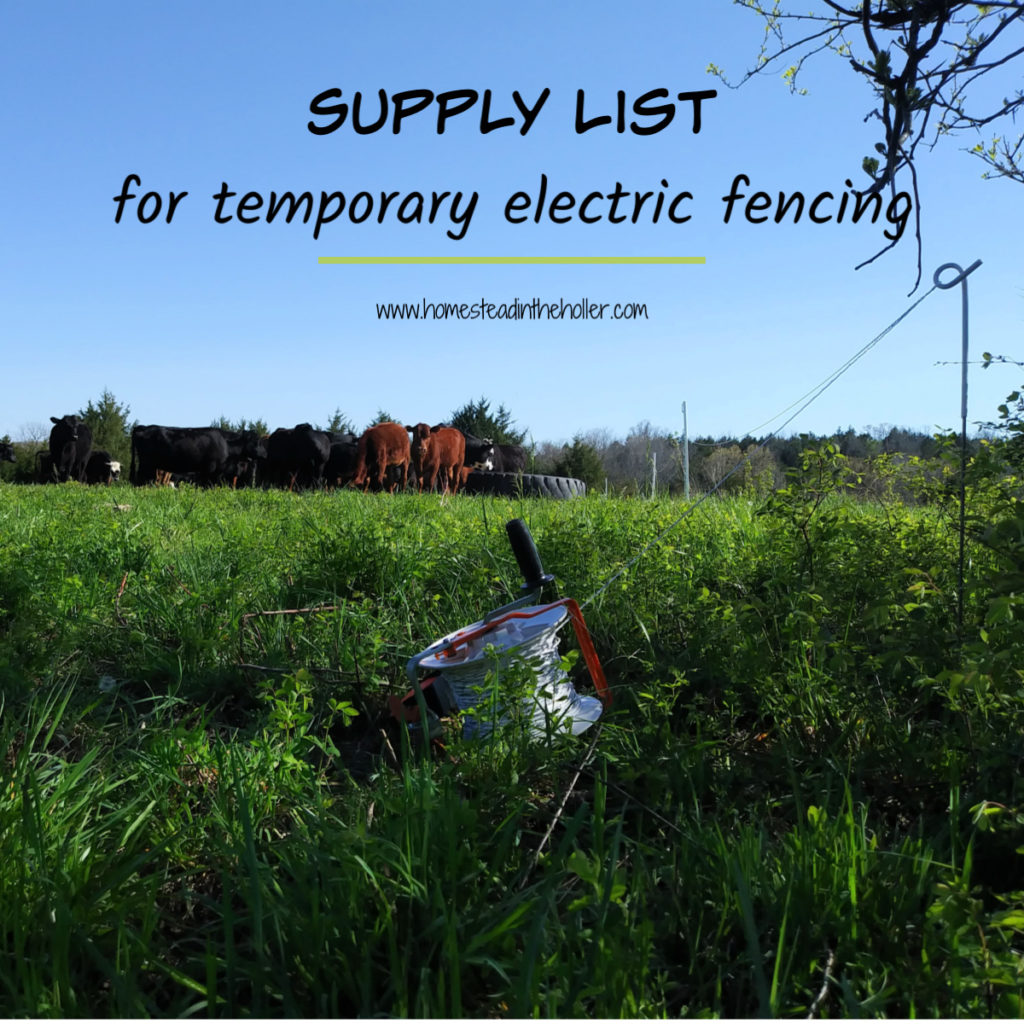
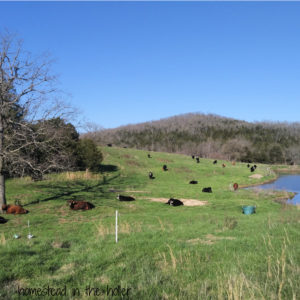
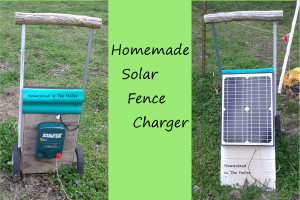
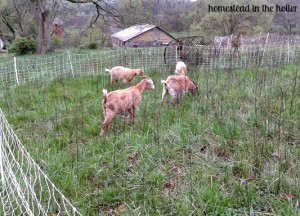
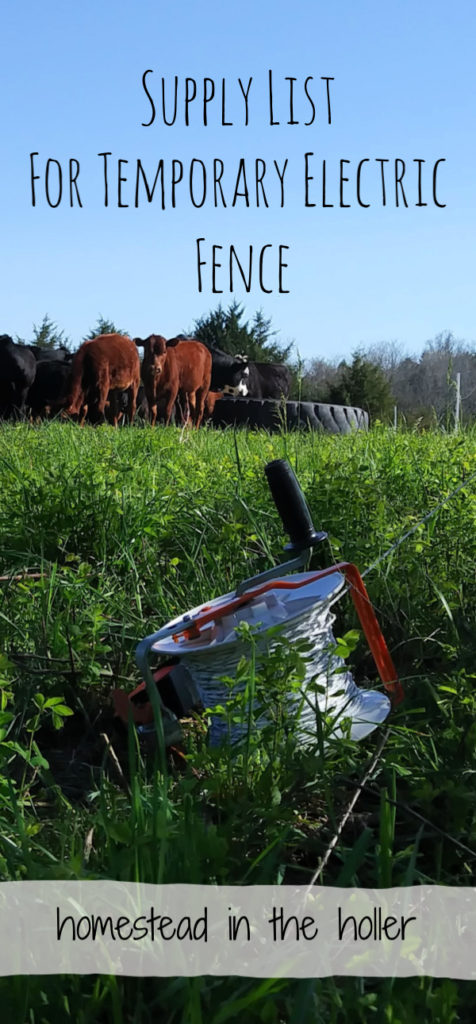

3 responses to “Electric fencing supplies”